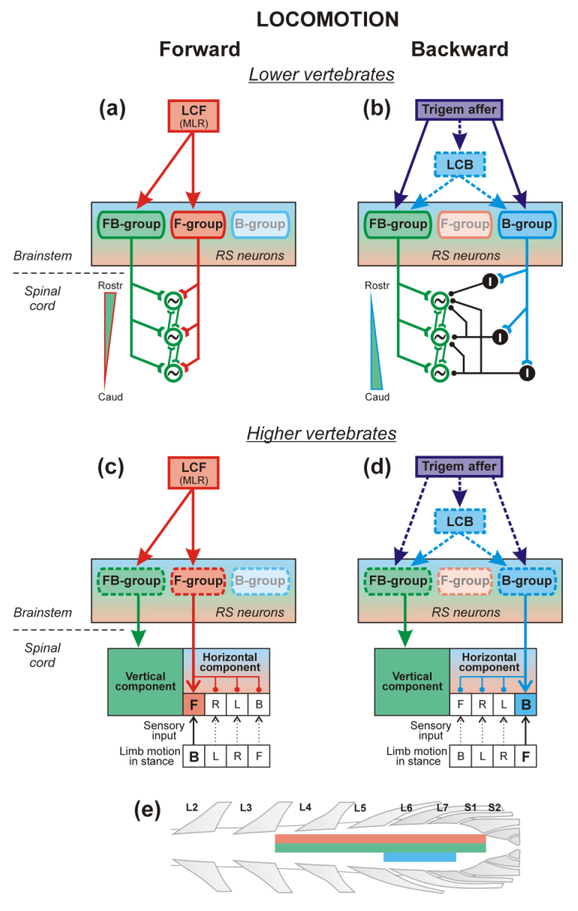Hypothetical neural mechanisms for the control of locomotion in different directions. (a-d) Hypothetical models of the spinal locomotor network and of the descending commands controlling forward (a,c) and backward (b,d) locomotion in lower (a,b) and higher (c,d) vertebrates. (a,b) The spinal locomotor network in lower vertebrates consists of segmental oscillators (green circles) that excite one another and thus form a chain, along which the waves of activity propagate. (a) Elicitation of forward swimming. The MLR, which is a locomotor center for forward locomotion (LCF), activates reticulospinal (RS) neurons of FBgroup and F-group. FB-group activates the chain of oscillators generating the swim rhythm. F-group stabilizes an intrinsic rostro-caudal gradient of excitability of oscillators or creates this gradient (green ramp with red outline). As a result, the waves of activity propagate in the caudal direction. (b) Elicitation of backward swimming. Trigeminal afferents activate RS neurons of FB-group and B-group (possibly, through the locomotor center for backward locomotion, LCB). FB-group activates the chain of oscillators generating the swim rhythm. At the same time, neurons of B-group activate inhibitory neurons (I) that invert the gradient of excitability (green ramp with blue outline). This results in the caudo-rostral propagation of locomotor waves. (c,d) Spinal cord of higher vertebrates contains two principal mechanisms, one generating the vertical component of step (limb elevation and lowering), and the other generating the horizontal component (limb transfer from one extreme point to the other). The latter includes networks generating the horizontal component of step in different directions (for simplicity, only the networks generating steps in four directions – F, forward; B, backward; R, rightward; L, leftward are shown). These networks receive sensory input signaling the limb motion during stance. (c) Elicitation of forward stepping. The MLR activates specific populations of RS neurons (presumably, FB-group and F-group). FB-group activates a network generating the vertical component of step. At the same time, neurons of Fgroup activate a network generating the horizontal component for forward stepping. Sensory input signaling that the limb reached the extreme caudal position during stance (B) assists in initiation of the forward swing. (d) Elicitation of backward stepping. Trigeminal afferents presumably activate RS neurons of FB-group and B-group (possibly, through LCB). FBgroup activates a network generating the vertical component of step. At the same time, neurons of B-group activate a network generating the horizontal component for backward stepping. Sensory input signaling that the limb reached the extreme rostral position in stance (F), assist in initiation of the backward swing. (e) Rostro-caudal distribution in the lumbosacral enlargement of networks generating vertical component of the steps, horizontal component for forward steps, and horizontal component for backward steps, are shown schematically by thick green, red and blue lines, respectively.

An official website of the United States government
Here's how you know
Official websites use .gov
A
.gov website belongs to an official
government organization in the United States.
Secure .gov websites use HTTPS
A lock (
) or https:// means you've safely
connected to the .gov website. Share sensitive
information only on official, secure websites.
